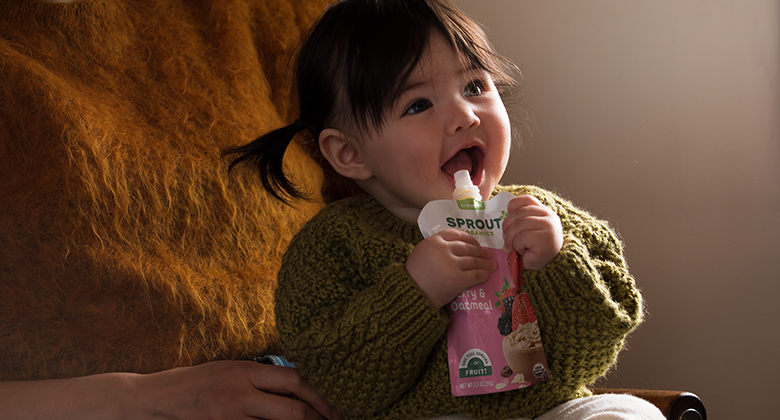Every baby is different and develops at their own pace. How do you know when it’s time to start solid foods? Sometimes it seems as if everyone has an opinion. We recommend always getting your pediatricians professional medical advice before feeding your baby solid foods.

The truth, though, is that there is no exact age or science for introducing solids; it’s all about your baby’s developmental progress.
Signs baby is ready for solid foods
The American Academy of Pediatrics recommends starting solids when your little one reaches the following milestones:
- Supports own head while sitting in an infant seat or high chair
- Shows interest in what you are eating
- Takes food from a spoon without rejecting it
Above all, your pediatrician has given your baby the green light to begin solids so make sure to check with them.
When you begin to integrate solid foods, most of your baby’s nutritional needs will continue to be met through breast milk or formula. While some, or even all, of the food may end up on your baby’s face, bib and clothes, there are important developmental reasons to offer solid foods.
Introducing solids helps your baby learn to feed from a spoon (or a spouted pouch!) and appreciate the flavors and tastes of real, wholesome food.

Tips for starting baby on solid foods
There are no hard and fast rules for how to introduce solids, but there are some strategies. Some parents begin with single-ingredient infant cereals, while others opt for simple, single-ingredient fruits or vegetables.
If you choose infant cereal, mix about 1 tablespoon of cereal with 2-3 tablespoons of breast milk or formula. The consistency should be somewhat thin to start. If you choose to lead with purees, select a single-ingredient fruit or vegetable puree with a smooth consistency.
Keep in mind that thinner consistencies are easier for your baby to swallow, and thicker textures and pieces should be introduced as your baby progresses.
When you decide it’s time to begin solids, here are a few tips:
- Breastfeed or bottle-feed your baby first, so that they are not too hungry or impatient to appreciate this new way of eating.
- Have your baby face you, either supported on your lap or in an infant seat or high chair.
- Use a softly-coated infant spoon to protect baby’s delicate gums
- Place a small amount of food on the tip of the spoon and bring it to your baby’s lips. They may try to suck it off the spoon, or they may open their mouth for the spoon. Let them try it their way and be sure not to empty the spoon into their mouth.
- Try letting your baby feed themself… they might just love showing off their independence!
- Remember that if your baby rejects a food at first, it doesn’t mean they won’t learn to like it eventually.
Reintroducing foods will help your baby learn to love a variety of tastes and flavors! Expect things to get a bit messy, and don’t be camera shy… you’re making milestones here!
Fruits or vegetables first for baby?
Luckily, the order of introduction of foods does not matter. The idea that if you give your baby fruits first, they will not like vegetables, and vice versa, has no basis in fact.
While babies are born with a natural “sweet” preference (making breast milk and formula acceptable), babies will acquire new tastes and preferences virtually every day.
There are a few things you can do to make fruits and vegetables and other flavors more appetizing from the get go:
- Introduce one flavor at a time so your baby can learn to like that flavor on its own
- Anticipate that it may take several tries before your baby likes a new food
- The earlier you introduce a variety of foods, the more likely your baby will be to explore and appreciate new tastes
It won’t always be easy. The first time your baby tries a new food, they may appear to reject it by making a face or even spitting it out. Realize that it is all new to them and they may simply be letting you know that they aren't quite sure just yet.
Keep trying! Let them learn to like the taste of a variety of wholesome fruits and vegetables, like sweet potatoes, peaches, carrots, and zucchini.
Bringing baby food textures to the table
Once your baby has mastered spoon-feedings of pureed foods, it may be time to introduce textures. You can gradually progress from thin purees to thicker purees, and then to chunkier purees. If you are wondering about the difference in these textures, imagine a fresh banana:
- Thin purees: Completely blended
- Thicker purees: Mashed well with a fork
- Chunkier purees: Mashed with some small lumps
When your baby can comfortably manage thicker, chunkier purees, offer some small pieces of soft foods that can be picked up. Start with soft textures or pieces of crackers.

Get solid baby food delivered to your doorstep
Our food is non-GMO with no concentrates or preservatives. If you’re looking for a variety of flavors, browse our variety of solid snacks and baby food for 6 months and up.

